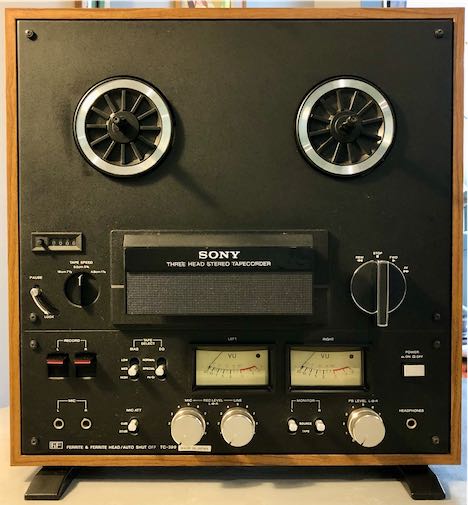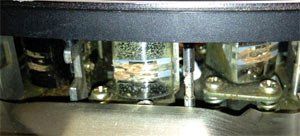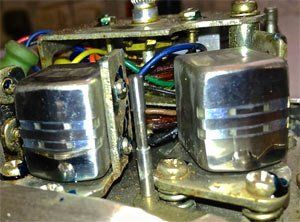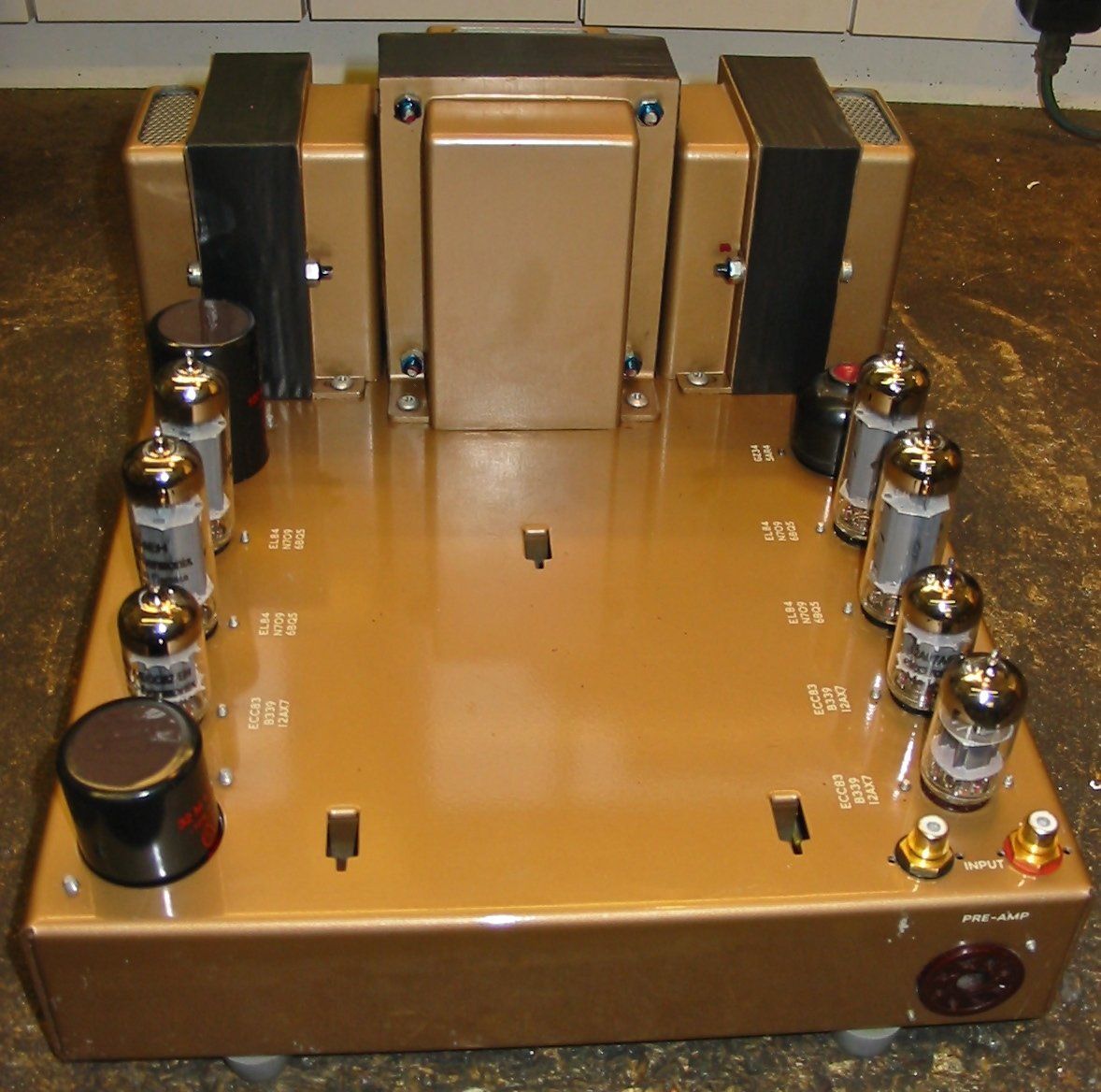Tips and Advice
Before I begin I must implore you to pay attention to a few warnings;
First of all if you have just discovered that old machine or amplifier lying in the attic or at the back of the garage please do not be tempted to simply plug it in and see what happens.
What might happen is nothing or it might start to work, it could also blow up, catch alight, blow fuses and perhaps fill the room with smoke and if it has a metal case it could electrocute you which can be fatal.
In the case of valve amplifiers, voltages as high as 1500 can reside for hours inside after the unit is switched off.
Do not be tempted to remove any covers, do not be tempted to take the valves out and do not be fooled into thinking that just because it works it will continue to work.
You must have the unit properly checked.
When we have machine in the first thing we do is to do an insulation test, if it passes that then the machine is taken apart and everything checked over. Electrolytic capacitors are especially prone to leaking both electronically and mechanically and are replaced as a matter of course.
The machine or amplifier is then run up with a Variac which is a voltage adjustable transformer, we have a 2kW Claud Lyons unit.
We start from about 50 volts and over the course of an hour slowly raise the mains voltage until the unit is running on full mains potential where it will sit for an hour or two.
Tape Recorders
Important information about tracks, speeds and models.
For those new to reel to reel machines and who wish to obtain a machine to use, you need to be aware of a couple of pitfalls especially if you have tapes that have been recorded on another machine which now need to be played back.
The 'channel / track' confusion -
The channel is the number of electronic recording and playback amplifiers a machine has. A single channel machine is Mono. Two channel machines are stereo and some multi track studio machines can range too 24 channels.
Most quarter track machines are either Mono (one channel) or Stereo (two channels).
One confusing element is the track configuration or layout which is shown below.
The other is the tape speed. This can range from 15/16 ips to 30 ips (ips = inches per second).
Most home and semi professional machines can be switched between 1 7/8ips and 3 3/4ips or 3 3/4ips and 7 1/2ips and some three speed machines can include 15ips. There is a short list of machines and their track, speed configurations at the end of this. A lot of the early mono machines such as Grundig were single speed and fixed at 3:3/4 ips.
(Some machines, Akai in particular, have a small sleeve which fits over the capstan shaft to double its diameter and thus the speed. In addition there is a switch to change the recording and playback characteristics and is marked 3.3/4 and 7.1/2 but confusingly, this is not a speed change switch!).
Description of track layout.
Half Track
Half track stereo -
All the tape is used and split into two tracks for stereo. You can only record on the two tracks and only in one direction. You can record two mono signals, one on each track.
Half track mono -
1/2 track machines have only one track usually at the top and you would turn the tape over to record/play the other track.
Quarter Track
Quarter track stereo
-
The tape is split into four tracks. For stereo they are paired thusly;
Tracks 1 and 3 are recorded in the forward direction. Tracks 2 and 4 are recorded in the reverse direction relative to tracks 1 and 3. Having recorded on tracks 1 and 3 and with all the
tape now on the right hand reel, the reel is removed, turned over and put in place of the now empty left hand spool, you can now record on tracks 2 and 4.
Playing back is the reverse of this operation.
Quarter track Mono -
To play/record Mono on a ¼ track Mono machine. The machine will have a track select switch marked 1-3 and 2-4. Some have an extra setting combining 1-3 (2-4) to play stereo recorded tapes back in Mono.
To play or record on a single track you would switch to Track1. Record/play to its end, wind the tape back, select Track 2 record/play to its end, turn the tape over so the full reel is on the left, select Track 3, record/play to its end, wind back and select Track 4 record/play to its end. Most stereo machines have the ability to record/play in mono on all four tracks.
If you have a tape recorded in Mono and are playing it back on a stereo machine, tracks 1 and 3 and 2 and 4 respectively will be played back through the left and and right channels thus, you may have track 1 played through the left channel while at the same time track 3 might be played through the right channel, you will need to choose the channel you want to listen to by either disconnecting the playback lead from the other channel or, if it has one, turning the balance control to mute the other channel or if it has separate output level controls, leaving the control for the other channel at zero.
You cannot play back a tape recorded on a quarter track machine on a half track machine since you will hear two tracks playing simultaneously.
You can play a tape recorded on a half track machine on a quarter track machine albeit with slightly reduced quality.
There are some machines that have the ability to play back both quarter and half tack recordings. These machines have an additional play back head, usually half track, and a small switch to select between quarter and half track play back.

Tape recorder track configuration
Tracks, channels and fractions. Understanding the terminology is important.
A quarter track machine is NOT a four track or four channel machine, they are distinctly different.
A quarter track machine is designed for home stereo, or four mono recordings to double the available tape time. The tape is split into quarters hence; quarter track.
A four track or four channel machine is a multi track design with four separate and independent channels and tracks that can record four separate signals simultaneously in one direction. Multi track/channel machines can range too 24 tracks, these are used mostly for studio work. You cannot play a tape recorded on a multi track machine on a quarter or half track machine, unless you are very lucky and only a few tracks have been recorded on.
Playing back a tape recorded on a ¼ track mono recorder (all tracks used), on a stereo machine -
If you have tape recorded on an old mono ¼ track machine, say a Grundig or Philips and now wish to play the tape back on a ¼ track stereo machine you will find that one track will play out of the left channel and another second recording will play out of the right channel. You need to use just the channel, left or right, to listen to the individual recordings. This applies especially if you are transferring material to a CD.
Tape. For brand new tape go to https://www.thomann.de/gb/index.html
Recording tape comes in various widths, ¼ inch, ½ inch, 1 inch, 2 inch. The most common is ¼ inch with the other sizes reserved for multi track machines.
A few machines and their track/ speed variants.
Below are just a few of the common variants, some makes and models have special features.
Sony; mostly ¼ track, some ½ track, stereo, two and three speeds dependant on model. Well built but the big machines can have troublesome electronic problems.
Akai; mostly ¼ track stereo, two speed, some have auto reverse.
TEAC; mostly ¼ track some ½ track, stereo, two speed. Some can play and record in the opposite direction without the need to dismount the tape thus saving the irritation of swapping the reels over.
Tandberg; mostly ¼ track some ½ track, stereo, three speed.
Ferrograph; ranges from ¼ track or ½ track, two and three speed, mono and stereo all dependant on model and year. H denotes high speed 15ips. L denotes low speed down to 15/16 ips. Series 2, 4, 5 and 6 are all valve based, all Series Seven machines are transistorised and sound as good as the valve based ones.
Brenell; ¼ track and ½ track, three speed (five speed,15/16 ips too 15ips with brass converter bobbin), mono and stereo dependant on model.
Vortexion; see Ferrograph as they use the Ferrograph (Wright and Wear) deck. Comes in mono and stereo versions.
Revox; ¼ and ½ track, two speed, stereo, H denotes high speed 15ips. The G36 and variants are valves based and can be difficult to repair.
Pioneer; ¼ track, two speed stereo. Some have auto reverse play/record. Pinch rollers and belts deteriorate, high head wear.
Technics; ½ track with switchable ¼ track play only head, two speed, stereo. An interchangeable ¼ track recording head block can be fitted. High head wear.
To get the best out of any tape recorder all heads must be spotless and you should use brand new tape and not 'new old stock' even if it is still in its wrapper, remember it will still be over 30 years old
Freshly manufactured tape can be had from: https://www.thomann.de/gb/index.html
The following will tell you how to look after your machine
Tape Head Care
Materials –
- Isopropyl Alcohol, which can be bought from any chemist.
- Solvol Autosol chrome polish, which can be bought from most motoring shops such as Halfords.
- Good quality Cotton buds.
- Nail Polish Remover.
'Nail Polish Remover sounds counterintuitive but it works better than anything I've come across and because it evaporates so fast, does not harm the rubber but do not bring it near anything plastic'.
Method -
- Start by cleaning the heads with a cotton bud dipped in alcohol.
- Next dip a fresh bud into a little of the polish and with a firm side to side action polish the head face.
- With a clean bud polish the head surface until it is mirror like.
- With a fresh bud dipped in alcohol, give the head a final clean.
- Do this to the tape guides as well. This will improve the tape contact with the head and thus the quality of the recordings.
- Finally, clean the rubber pinch wheel with Nail Polish Remover to remove all tape residue.
On early Ferrograph’s the pinch wheel is brass and the rubber surface is applied to the capstan shaft itself. Clean this but be very careful not to dig into it as the rubber coating is thin.
‘Micro Polish’ the heads and guides only once in a while, perhaps twice a year and clean everything with alcohol after every second full reel of tape. When preparing to record, clean all the heads and guides even if they look clean.
If you are going to use Solvol Autosol to polish the heads use just the slightest amount on a cotton bud, do not apply the Solvol Autosol directly to the heads.

Machines to begin with -
I do not touch Philips and their variants of any sort!
If you are new to reel to reel machines and would like to get one here is a list of some that will offer good performance and are easy to use.
Ferguson/Ultra/HMV made by the Thorn EMI group; Nice small home machine, mostly mono ¼ track, two and three speed, some stereo. Sound is brilliant considering their simplicity. All have built in speakers. Tend to seize up but not a problem to service and do not have any major issues.
Sony; TC-366, TC-377, TC-399 Good, reliable, solid and easy to use machines once properly serviced, new belts are a must and the auto shut off system must be serviced correctly. Arguably one of the best small "home" machines ever made.
Akai; 4000 range and GX-4000, early ones can have electronic problems and head wear but the heads can often be refaced. Simple to use but can be delicate and break easily. Some alloy parts disintegrate rendering the machine unrepairable. With the 4000 range, make sure it has the high speed sleeve, note that the GX-4000 has the sleeve parked under the plastic pull off head cover when not in use. One issue is with the early 4000 machine with the crude integrated circuits, these break down. There are discrete replacements but these are relatively expensive.
Tandberg; almost all of their machines are excellent although they can be expensive to service. Nice sounding. Some early ones have built in speakers. Pinch rollers and belts commonly deteriorate and the cork clutches disintegrate but new ones can be made, can be expensive to service.
Brenell; are superb machines but MK6 and STB2 machines have issues when fitted with Bogen heads, be very careful. Semi professional use. Most have built in speakers. Electronics need careful attention. If the heads have gone open circuit the machine is likely to be beyond repair.
TEAC; Most are very good, all suffer from head wear but the heads can often be refaced. Semi professional use.
Do not touch the X-1000 and X-2000 range, they have servo system issues which cannot be corrected.
The best are, X-300, X-10, X-7. If there is an R in the model it denotes a reversible play/ record machine with six heads. Capstan belts deteriorate, pinch roller mechanisms seize, not a problem though, very well built. Four channel machines are nice and simple, well built and easy to service. Teac 4 channel machines are good but if the heads are heavily worn they are not available and second hand ones are a fortune.
Revox B-77, A-77, A-700; Professional/ semi pro use. No real issues once serviced properly but can be expensive to do so, spares are very very expensive. A-77 must have capacitors replaced in the amplifiers and motor controller. All models can be delicate. B-77 switches break and are a fortune to replace. Pinch rollers, brake bands and counter belts deteriorate but can be got for a price. Heads are a fortune if needed. Plastic parts break and mark, the tape end shut off sensor is troublesome and expensive to replace. Delicate and plasticky. Almost impossible to clean the heads properly without taking half the machine apart. Early 36 valve machines are difficult to repair.
Ferrograph; all are superb and are probably the best sounding machines ever made. They come in a vast array of variants and many were made specially for the BBC and armed forces. Professional and home use. Some have built in speakers and superb amplifiers. Heads can be refaced. Series Seven, Super Seven and Logic; pinch rollers and idlers deteriorate but are available without trouble. The Series Seven benefit from a spooling motor bearing modification which is part of the service. Half track Sevens work perfectly well with the pressure pads and arms removed so long as the heads are refaced. Some capacitors in the amplifiers are replaced as a matter of course. No problems with servicing and spares. Built like a tank and nearly as heavy!
Grundig; early ones can be OK but may cost a relative fortune to service correctly, often the alloy parts on the earlier models perish rendering the machine unrepairable. Early models (TK14) must have all the 'Wima' branded capacitors replaced which is costly compared to the value of the machine.
Telefunken; mostly domestic machines, no parts available and some of the belts are impossible to match up but they are often ok with a service.
The above is a very rough guide to a few of the commonly available machines. When you are choosing a machine, make sure it will do what you need it to do. There is no point getting a 4 channel machine if you intend recording and playing back stereo tapes.
For new tape supplies contact;
Some don'ts
PLEASE DO NOT BE TEMPTED TO ALTER ANY OF THE ALIGNMENT ADJUSTMENTS.
- If you think the tape path or heads are out of alignment you should entrust this work to a competent engineer who has the right equipment and test tapes.
DO NOT TOUCH THE HEADS OF YOUR MACHINE WITH ANY METALIC OR HARD OBJECT.
- This will permanently damage the heads.
DO NOT BRING ANY MAGNET OR MAGNETISED OBJECT NEAR YOUR MACHINE OR TAPES.
- This includes speakers and mains transformers. Data is stored on the tapes magnetically and will be damaged if exposed to magnetic fields.
DO NOT LUBRICATE ANYTHING UNLESS YOU KNOW WHAT YOU ARE DOING.
- Music tapes and rubber in the machine can be damaged by lubricants.
DO NOT SWITCH OFF YOUR MACHINE WHILE PLAYING, RECORDING OR WINDING A TAPE.
- This will stretch and damage the tape.
Some do's
DO CLEAN THE HEADS, GUIDES AND RUBBER PINCH ROLLERS REGLULARY.
- See the instruction above for advice about this.
USE NEW TAPE FOR RECORDING WHENEVER POSSIBLE.
- This will improve the quality of your recordings.
DO HAVE YOUR MACHINE SERVICED AT LEAST EVERY TWO YEARS.
- This will keep your machine in tip top condition.
USE YOU TAPE RECORDER AT LEAST ONCE A WEEK.
- This will keep everything in good order.
HAVING RECORDED A REEL OF TAPE, MAKE SURE YOU STORE IT ON THE FINISHED SPOOL (THE RIGHT-HAND SIDE)
- This is to negate ‘print through' from the adjacent layers of tape.
DO HAVE THE TAPE HEADS DEGAUSSED OR DE-MAGNETISED EVERY FEW MONTHS.
Tape Shedding and Head Wear
The biggest problem is contamination from old tape. Often, old and poorly stored tapes can shed its oxide coating covering the heads and guides in dust which builds up into a hard cake which will dull and distort the sound of recordings and if bad enough will prevent the machine recording at all. If you do not keep the heads clean the machine will not work properly. If you have any Ampex or Quantegy you must not use it as it is likely to shed.
Symptoms of Oxide shedding
Rapid deterioration of playback and recording quality especially the high frequencies.
No recording on one or more tracks.
Fast winds becoming sluggish.
Screeching or squealing sound which alters with tape speed.
Tape jamming in machine and becoming stuck to the heads and guides.
If you have a tape that sheds oxide but must be played in order to transfer its contents, you must make sure the heads and guides are regularly cleaned throughout the process, perhaps when there is a gap in the recording.

The picture above is of a recently serviced Akai which came back with the complaint that it sounded wooly and had stopped recording. Clearly shown is the result of Tape Shedding. Notice the pin guides have become contaminated too. The owner did not bother to clean or even inspect the heads even though he was asked to and had to pay to have the heads cleaned again.

This is what the heads should look like. If you have any tape that sheds oxide, you should replace it with newly manufactured tape such as EMTEC and RMG which can be obtained from Tape City and Thomann
https://www.thomann.de/gb/index.html
Tips & Advice ~ 2. Valve Amplifiers
First of all Servicesound would like to make one thing clear.
Valve equipment, of all types, operates at very high (lethal) voltages. No attempt to service, alter or even touch the internal workings of any valve equipment should be made by anyone who is not competent. Servicesound do not accept liability for any damage to equipment or persons arising from this article.
Some don'ts
DO NOT EVER RUN ANY POWER AMPLIFIER WITHOUT SPEAKERS CONNECTED.
- You run the risk of severe damage to the output transformers and valves.
DO NOT ATTEMPT TO CONNECT A SIGNAL LEAD WHEN THE AMPLIFIER IS ON.
- There is a good chance of blowing up your speakers.
DO NOT TRY AND REMOVE A VALVE WHILE THE UNIT IS RUNNING.
- You will burn yourself and perhaps damage the amplifier and speakers.
DO NOT SWITCH A VALVE AMP OFF THEN IMEADIATLY ON.
- This can harm the valve filaments and blow fuses. You should leave the amp at least 1 minute before switching back on.
DO NOT ALTER THE MAINS VOLTAGE SETTING.
- The mains voltage in the UK is 240 volts. If your amplifier has an adjustable mains sector do not alter it in an effort to get more power or overcome aged valves. You will damage your equipment.

Note: Valve amplifiers operate at very high voltages inside. These voltages can run to over 600 volts that will remain for some time after switching off. You must allow at least an hour for these voltages to disperse before removing a valve. Do not attempt to remove the covers unless you know what you are doing. These voltages are lethal
Some do's
ALLOW PLENTY OF VENILATION ALL AROUND.
- If you must place an amplifier on the floor make sure it is placed on a solid base. There must be plenty of air underneath. Some amplifiers, such as Leak, do not have feet and it is wise to have some fitted.
USE DECENT SPEAKER AND INTERCONNECT CABLING.
- You do not have to spend a fortune but do not use bell wire/ car speaker cable or the free interconnects that come with most equipment. QED do a superb range of low price cables and 2.5 mm solid mains cable makes a great budget speaker cable.
MAKE SURE YOUR SPEAKERS ARE CONNECTED CORRECTLY.
- Speakers must be connected to the correct terminals on both the speaker and the amp. "+ " to "+" and "-" to "-" or "red" to "red" and "black" to "black". Connecting a speaker out of polarity will cause a big hole in the soundstage and a lack of bass.
REMOVE VALVES CAREFULLY.
- Some of the big valves can be tight in their bases. A very small side to side movement while pulling upward will ensure they are safe. Smaller valves should be removed by just pulling. Do not wobble them from side to side with any force as this will damage the contacts and could break off the locating pin on larger valves. Before removing, allow them to cool down.
ALLOW THE VALVES TO BURN IN.
- Normally at least 48 hours of continuous is needed before the benefits of new valves are heard.
BIASING.
- Some amplifiers have manual biasing adjustments. These should be set up by an experienced engineer who has the appropriate test equipment. This should be done when you replace the output valves and at regular intervals between.

